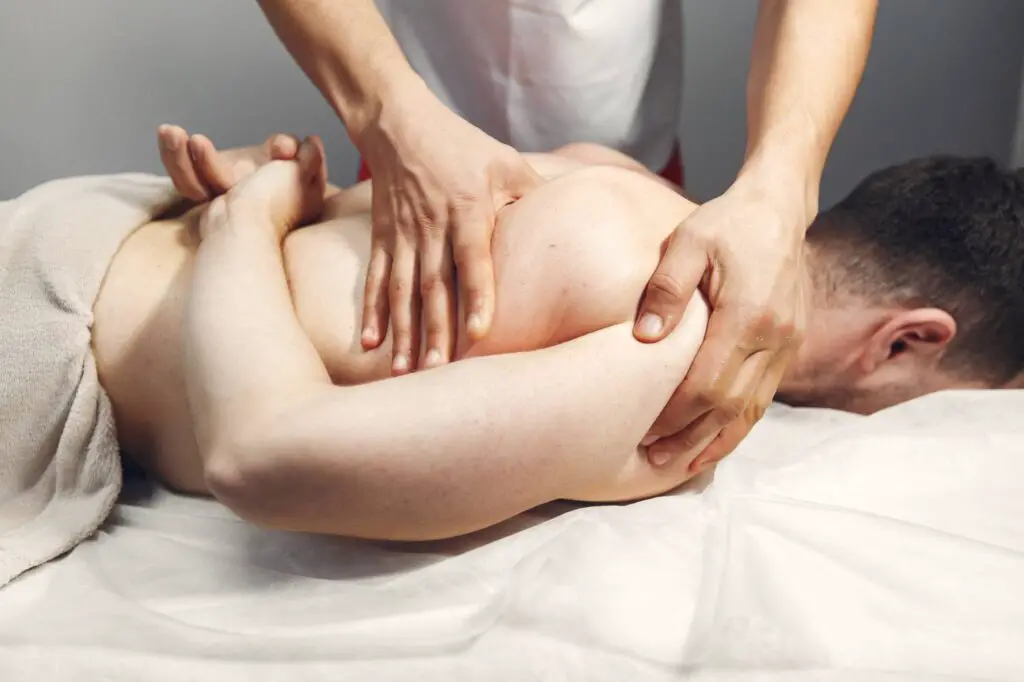Introduction
Can Massage Help With Weight Loss: In the ever-evolving landscape of weight loss strategies, there is a growing interest in holistic approaches that extend beyond the traditional realms of diet and exercise. One such approach that has gained attention is massage therapy. While the primary purpose of massage is typically associated with relaxation and stress relief, a question arises: Can massage help with weight loss?
“Can Massage Help With Weight Loss” delves into this intriguing intersection of wellness and weight management, aiming to provide clarity on the potential benefits of massage as a complementary tool in the pursuit of a healthier body.
Massage therapy, with its origins dating back thousands of years, has long been revered for its ability to soothe the mind and rejuvenate the body. Beyond its therapeutic qualities, there is emerging evidence suggesting that massage may have indirect effects on weight loss. Stress, a common modern-day affliction, is known to influence eating habits and contribute to weight gain. Massage is known to reduce stress and promote relaxation, it may indirectly support healthier eating behaviors and emotional well-being, which are essential components of successful weight management.
Embarks on a journey to uncover the potential mechanisms by which massage can contribute to weight loss. We explore how massage can alleviate stress, reduce cortisol levels (a stress hormone linked to weight gain), improve sleep quality, and boost overall feelings of well-being—all factors that can impact weight management.
We examine the role of lymphatic drainage massage, a specialized technique that aims to enhance the body’s natural detoxification process and reduce fluid retention. While not a direct means of shedding fat, lymphatic drainage massage can play a role in achieving a leaner appearance and may be an adjunct to weight loss efforts.
It’s essential to approach the topic of massage and weight loss with realistic expectations. Massage is not a magic solution for rapid weight loss but rather a complementary approach that, when combined with a balanced diet and regular exercise, can potentially enhance your overall wellness journey.
Join us as we embark on a voyage through the world of massage therapy and its potential contributions to the complex and multifaceted realm of weight loss. Through knowledge and understanding, we aim to shed light on the holistic benefits that massage can offer those seeking a healthier and more harmonious relationship with their bodies.

Which massage is good for weight loss?
Many studies suggest abdominal massage for weight loss is effective. It treats constipation, bloating, and diarrhea. It helps treat constipation by relaxing smooth muscles. It improves digestive function.
While massage therapy isn’t a direct method for weight loss, certain massage techniques may indirectly support weight management by promoting relaxation, reducing stress, and improving overall well-being. Some massage styles that are often recommended in the context of weight management and well-being include:
Swedish Massage: This gentle, relaxing massage style is known for reducing stress and promoting relaxation. By alleviating stress, it may indirectly support better eating habits and overall emotional well-being, which can aid in weight management.
Deep Tissue Massage: Deep tissue massage can help release muscle tension and improve circulation. This can be beneficial for individuals who engage in regular physical activity as part of their weight loss routine, as it may help reduce muscle soreness and improve recovery.
Lymphatic Drainage Massage: This specialized technique focuses on improving lymphatic circulation and drainage. While it doesn’t directly burn calories or reduce fat, it can help reduce fluid retention, contributing to a leaner appearance.
Hot Stone Massage: The heat from the stones in hot stone massage can help relax muscles and reduce tension. Like Swedish massage, it promotes relaxation and stress reduction, potentially supporting weight management indirectly.
Aromatherapy Massage: Aromatherapy massage combines massage with essential oils, which can have calming and stress-reducing effects. This type of massage can enhance the relaxation benefits of massage.
It’s important to understand that massage is not a substitute for a healthy diet and regular exercise when it comes to weight loss. Instead, it can be a complementary tool to promote relaxation and well-being, which can indirectly support a balanced approach to weight management.
Do massages help with losing weight?
So, can massage cause the body to burn fat cells? The short answer is No. Massage cannot cause the body to burn fat cells or reduce body weight on its own. However, massage can be a useful tool to support a healthy weight-loss journey when combined with other healthy habits.
Massages alone are not a direct method for losing weight, as they do not burn a significant number of calories or reduce body fat. Weight loss primarily depends on creating a calorie deficit through diet and exercise. However, massages can play a supportive role in the broader context of weight management.
Massage therapy, particularly techniques that promote relaxation like Swedish massage or aromatherapy massage, can help reduce stress. Chronic stress can lead to emotional eating and poor dietary choices, which can contribute to weight gain. By alleviating stress and promoting relaxation, massages can indirectly support healthier eating behaviors and emotional well-being, which are essential aspects of successful weight management.
Massages can help with muscle recovery and reduce muscle tension, which can be beneficial for individuals engaging in regular exercise as part of their weight loss regimen. Massage can help alleviate post-workout soreness and improve overall physical comfort.
While massages themselves are not a weight loss solution, they can enhance the overall well-being of individuals on a weight loss journey, making it easier to adhere to a healthy lifestyle.
Can massage reduce belly fat?
Yes it can!
There is some scientific evidence that you can lose some belly fat through regular massage.
Massage therapy, including techniques like abdominal massage, is not a direct method for reducing belly fat. Belly fat reduction primarily depends on creating a calorie deficit through a combination of diet and exercise.
However, abdominal massage may have some indirect benefits related to digestion and overall well-being. Abdominal massage can help with relaxation, alleviate tension in the abdominal muscles, and potentially improve digestion and gastrointestinal comfort. When combined with a balanced diet and exercise routine, improved digestion and reduced discomfort can contribute to better adherence to a weight loss plan.
It’s important to note that spot reduction (targeting fat loss in a specific area of the body, such as the belly) is generally not effective. Weight loss typically occurs uniformly across the body as individuals lose overall body fat through a calorie deficit.
Does body massage burn calories?
An hour-long massage can burn more calories than you might think — 230 calories — the same as an hour of light weight training. And an hour of passionate playtime kills 270 calories, which would burn off a frosted cupcake.
Body massage, including popular styles like Swedish massage or deep tissue massage, does not burn a significant number of calories. The primary purpose of massage is to promote relaxation, reduce muscle tension, and enhance overall well-being rather than to serve as a calorie-burning activity.
Weight loss primarily relies on creating a calorie deficit, where you consume fewer calories than you burn through activities like exercise and daily bodily functions. Activities like aerobic exercise and strength training are more effective for burning calories and supporting weight loss.
While massages do not directly burn calories, they can play an indirect role in weight management by reducing stress and promoting relaxation. Chronic stress can contribute to poor eating habits and emotional eating, which can hinder weight loss efforts. By alleviating stress, massages can indirectly support healthier eating behaviors and emotional well-being, making it easier to adhere to a balanced diet and exercise routine conducive to weight loss.
Does massage reduce thigh fat?
Massages do work to reduce the dimpling of skin that comes with the accumulation of fat, better called cellulite. But these massages cannot fix the problems permanently. Experts and researchers suggest that such massages can work great as a temporary solution but are not a permanent fix.
Massage therapy, including techniques like thigh massage, is not a direct method for reducing fat in specific areas of the body, including the thighs. Fat loss primarily occurs through a calorie deficit, where you consume fewer calories than you burn through activities like exercise and daily bodily functions. This results in overall body fat reduction rather than targeted fat loss in specific areas.
However, massage can offer some indirect benefits that can be relevant to individuals seeking to improve the appearance and health of their thighs:
Improved Circulation: Massage can enhance blood circulation, which may help with the mobilization of stored fat in the body. While it doesn’t lead to localized fat loss, improved circulation can support overall cardiovascular health.
Muscle Relaxation: Thigh massages can help relax and alleviate tension in the thigh muscles. This can be especially beneficial for individuals who engage in regular physical activity or experience muscle soreness in the thigh area.
Lymphatic Drainage: Certain massage techniques, like lymphatic drainage massage, focus on promoting lymphatic circulation and reducing fluid retention. While this doesn’t directly reduce fat, it can contribute to a leaner appearance in the thighs by reducing excess fluid retention.
In summary, while thigh massages do not directly reduce thigh fat, they can support overall well-being, muscle relaxation, and circulation, which may indirectly contribute to an improved appearance and comfort in the thigh area.
How often should I get a massage?
For general tune-ups, consider scheduling a massage every four to six weeks. If you have a chronic condition or specific areas of strain and tension, consider scheduling a message every one to three weeks. If you’re still unsure how often to get a massage, consider scheduling a consultation appointment.
The frequency of massage sessions depends on individual preferences, needs, and goals. There is no one-size-fits-all answer to how often you should get a massage because it can vary based on factors like stress levels, physical condition, and budget.
For general relaxation and stress relief, many people find that a monthly massage session is sufficient to maintain a sense of well-being and relaxation. This frequency allows for consistent self-care and stress management.
If you have specific physical issues, chronic pain, or muscular tension, you might benefit from more frequent massage sessions initially. In such cases, weekly or bi-weekly massages may be recommended to address and alleviate your specific concerns. As your condition improves, you can consider spacing out the sessions.
Athletes or individuals engaged in intense physical training may incorporate regular massages into their routine to aid in muscle recovery and reduce the risk of injuries. In these cases, massages may occur more frequently, such as every 1-2 weeks, especially during peak training periods.
Ultimately, the frequency of massage should align with your goals, physical condition, and budget. Consulting with a licensed massage therapist is advisable to determine the ideal frequency based on your specific needs and circumstances. They can provide personalized recommendations and help you create a massage schedule that supports your overall well-being.
Does coconut oil massage reduce belly fat?
Yes, coconut oil helps to reduce body fat. This oil contains medium-chain fatty acids, stimulating body fat loss, especially abdominal fat. It stimulates the body’s metabolism and suppresses appetite in individuals. It helps curb the constant food cravings for carbohydrate-rich foods by initiating satiety.
There is no scientific evidence to suggest that coconut oil massage directly reduces belly fat. Weight loss and fat reduction primarily depend on creating a calorie deficit through a combination of diet and exercise. Reducing fat in a specific area, such as the belly, typically occurs as a result of overall fat loss from the body rather than through targeted treatments like massages with coconut oil.
Coconut oil is often used in massages because of its pleasant scent and smooth texture, which can enhance the massage experience. While coconut oil is a source of healthy fats and can be part of a balanced diet, it should be consumed in moderation to avoid excessive calorie intake. In essence, applying coconut oil to the skin during a massage may provide benefits for skin hydration and the overall relaxation experience but should not be relied upon as a primary method for belly fat reduction.
If your goal is to reduce belly fat, it’s essential to focus on overall weight loss strategies, including a well-balanced diet and regular physical activity. Spot reduction (targeting fat loss in a specific area) is generally not an effective approach, and sustainable weight loss is achieved through a holistic and comprehensive lifestyle change.
Is Ayurveda good for weight loss?
Ayurvedic detox (panchakarma) is very beneficial for accelerating weight loss. It gives your digestion a chance to rest, while it clears the toxins from your system. It presses the ‘reset’ button on your metabolism and supports your body to find a healthy balance.
Ayurveda, a traditional system of medicine rooted in India, offers holistic approaches to health and well-being, including weight management. Ayurveda emphasizes a personalized approach, taking into account an individual’s unique constitution (dosha), lifestyle, and dietary habits.
Ayurveda offers various strategies for weight loss, including dietary recommendations, herbal remedies, detoxification practices, and lifestyle modifications. These approaches are typically tailored to an individual’s specific needs and imbalances.
Some Ayurvedic principles that may support weight loss include:
Balanced Diet: Ayurveda emphasizes a balanced diet that aligns with an individual’s dosha and includes whole, unprocessed foods. It discourages overeating and promotes mindful eating.
Herbal Supplements: Ayurvedic herbs like triphala or guggul are sometimes used to aid digestion and metabolism.
Detoxification: Panchakarma, an Ayurvedic detoxification process, is believed to remove toxins from the body and support weight loss.
Lifestyle Modifications: Ayurveda encourages daily routines that promote overall health, such as regular exercise, yoga, and stress management.
While Ayurveda offers potential benefits for weight management and overall well-being, it’s essential to consult with a qualified Ayurvedic practitioner or healthcare provider before embarking on any Ayurvedic weight loss plan. Individualized guidance is crucial to ensure that Ayurvedic practices are appropriate for your specific constitution and health conditions. Ayurveda should be viewed as a complementary approach to weight loss and should be combined with a balanced diet and regular physical activity for the best results.

Conclusion
In the pursuit of effective weight management and overall well-being, “Can Massage Help With Weight Loss” has taken us on a compelling journey through the world of massage therapy and its potential role in the complex landscape of weight loss. While massage therapy is not a standalone solution for shedding pounds rapidly, it does offer a range of indirect benefits that can support a holistic approach to weight loss. One of the most notable contributions of massage is stress reduction. Chronic stress can lead to emotional eating and poor dietary choices, which in turn can contribute to weight gain. By alleviating stress and promoting relaxation, massage can indirectly aid in healthier eating behaviors and improved emotional well-being—a crucial component of successful weight management.
The potential of lymphatic drainage massage to reduce fluid retention and enhance the body’s natural detoxification process may contribute to achieving a leaner appearance and improving overall well-being. Although this technique is not a direct means of fat loss, it can play a role in enhancing the results of a well-rounded weight loss plan.
It’s important to approach massage as a complementary tool within the broader context of a balanced diet, regular exercise, and a healthy lifestyle. Weight loss is a multifaceted journey that requires a holistic approach, and massage can be a valuable part of that journey.
It’s clear that massage therapy offers more than just relaxation; it offers the potential to create a positive ripple effect on various aspects of health and wellness, which can indirectly support weight loss. By incorporating massage into your self-care routine, you can foster a healthier relationship with your body, reduce stress, and improve overall well-being—all of which contribute to a more sustainable and fulfilling approach to weight management.

